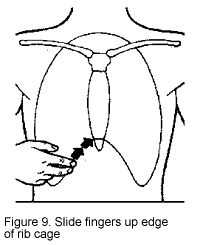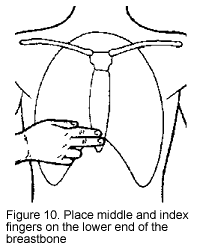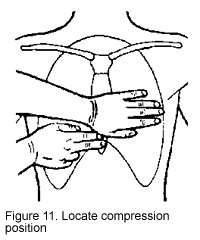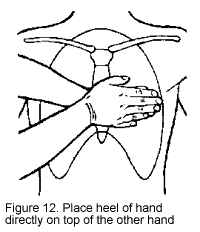Agriculture
is the most hazardous industry in the United States. Accidents
occur frequently with both adults and children. Thus, it
is important that children, as well as adults, know how
to handle emergency situations. Basic life-saving principles
that parents can share with their children are discussed
in the following sections.
The
most fundamental lesson parents and grandparents should
teach children is how to contact emergency assistance. This
may seem trivial, but it can make the difference between
life and death. Parents and grandparents can review the
following steps with children. Note: It is very important
that children know where they live and how to get to their
home!
In
addition to the emergency number for your area, children
should know the poison control number. Family members should
also know where other members of the family are working
and what time they are expected to return. If they are not
home by the expected time, someone should look for them.
Many accident victims could have been saved if help would
have arrived sooner.
It
is essential that children know that they should not enter
a silo or grain bin to rescue another person. If someone is
caught in one of these structures and a child enters, then
they too can become trapped. The child does need to know how
to turn off an operating auger and turn on a fan, if one is
present, and then get assistance.
The
same principle applies to manure dangers. If someone enters
a manure storage area and is overcome by the gases, a child
or adult should not enter the area to rescue the person.
Instead, the child should call the fire department so proper
breathing equipment can be brought to rescue the person.
Children should be taught where and how to turn off all farm
machinery. If a person becomes entangled, a child could save
his/her life by turning off the equipment and then getting
help.
Parents and grandparents should remind children to be very
cautious and alert when around any animal on the farm. Children
need to be aware of their location so they do not end up behind
an animal and get stepped on or kicked. Running or screaming
around animals can cause the animal to become spooked, which
could lead to injury to a child. Children also need to be
warned to stay away from any farm animal with its young. A
new mother can quickly turn on a child if she feels her young
are threat ned.
Very often it is a family member who is the first on the scene of a farm accident. If this person knows how to properly
respond to the emergency situation it could mean the difference
between life and death. Therefore, any time spent learning
first-aid is time well spent.
FIRST: Go to the nearest telephone
SECOND:
Dial the emergency number
THIRD:
When someone answers, they will need to know:
- Where
you are - be very specific - give the exact location;
give any landmarks, names of streets, intersections or
rural route number (Have your house number clearly posted!)
- Your
Name
- How
many people are hurt
- The
condition of the people hurt
FOURTH:
Do not hang up until you ask if you should!
WHAT ALL FARM
FAMILY MEMBERS SHOULD LEARN FROM A HEALTH PROFESSIONAL
The following
is a review of the basic steps required to perform Rescue
Breathing & CPR. Note: It is strongly suggested that parents,
grandparents and children take a CPR and first-aid course.
For more information, contact your county office of Ohio State
University's Cooperative Extension Service or the health department
in your county.
- Check
for unresponsiveness.
- Does
the victim respond?
- Tap
or gently shake the victim (see Figure 1).
- Ask
"Are you O.K.?" If there is no response shout, "Help!"
- Position
the victim.
- Roll
victim on back if necessary (see Figure 2).
- Roll
victim towards you as a single unit; as you roll victim,
support the back of head and neck (see Figure 3).
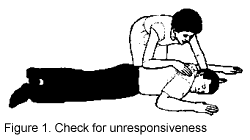
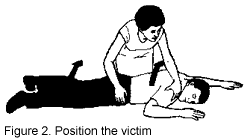
- Open
the airway.
- Place
your hand - the one nearer victim's head - on victim's
forehead.
- Place
2 fingers of other hand under bony part of lower jaw
near chin.
- Tilt
head and lift jaw. Avoid closing victim's mouth (See
Figure 4).
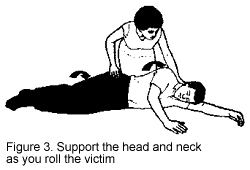
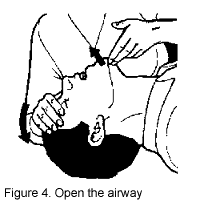
- Check
for breathlessness.
- Place
your ear over victim's mouth and nose.
- Look
at chest, listen and feel for breathing for 3 to 5
seconds (See Figure 5).
- Give
2 full breaths.
- Pinch
nose shut.
- Open
your mouth wide, take a deep breath and make a tight
seal around outside of victim's mouth.
- Give
2 full breaths. Look for chest to rise and fall. Listen
and feel for escaping air (See Figure 6).
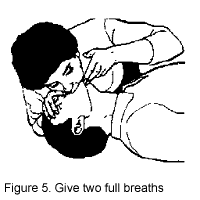
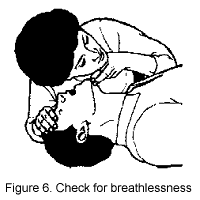
- Check
for carotid pulse.
- Locate
Adam's apple with middle and index fingers of other
hand.
- Slide
fingers down into groove of neck on side closer to
you.
- Feel
for carotid pulse for 5 to 10 seconds (See Figure
7).
- Phone
EMS for help.
- Tell
someone to call for an ambulance.
- Begin
rescue breathing.
- Give
1 breath every 5 seconds.
- Continue
for 1 minute - about 12 breaths (See Figure 8).
- Recheck
carotid pulse.
- What
to do next:
- If
pulse is absent, begin chest compressions.
- If
pulse is present but victim still not breathing, continue
rescue breathing.
- If
victim begins to breathe, maintain open airway, and
monitor breathing until EMS arrives.

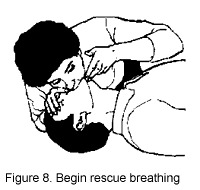
- CPR:
- Locate
compression position.
- Kneel,
facing victim's chest.
- With
middle and index fingers of hand, locate lower edge
of victim's rib cage on side closer to you.
- Slide
fingers up edge of rib cage to notch at lower end
of breastbone (See Figure 9).
- Place
middle finger in notch, and index finger next to it
on the lower end of breastbone (See Figure 10).
- Place
heel of hand nearer victim's head on breastbone next
to index finger of hand used to find notch (See Figure
11).
- Place
heel of hand used to locate notch directly on top
of heel of other hand (See Figure 12).
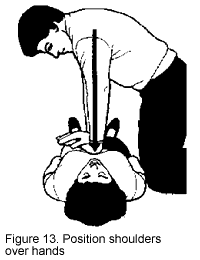
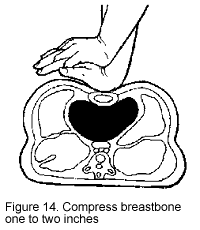

- Do
3 cycles of 15 compressions and 2 breaths.
- Recheck
carotid pulse
- Give
2 full breaths
- Continue
compression/breathing cycles
- What
to do next.
- If
there is still no pulse, continue CPR.
- If
pulse returns, check breathing.
- If
victim is not breathing, begin rescue breathing.
- If
victim is breathing, monitor until EMS arrives
Publication #: AEX-991.2
This
document is
a series of the Ohio State University Extension, Columbus,
Ohio 43210. Publication date: October 1992. Funded in whole
or in part from Grant Number U05/CCU506070-02, "Cooperative
Agreement Program for Agricultural Health Promotion Systems,"
National Institute for Occupational Safety and Health. Supported
in part by project #MCH394001-02-1 from the Emergency Medical
Services for Children program, Health Resources and Service
Administration Department of Health a d Human Services.
Thomas L. Bean, Safety Leader; Jennifer Wojtowicz, Graduate
Assistant, Ohio State University Extension, Columbus, Ohio
43210. Reviewed by Dr. Randall Wood, Dr. Sue Nokes and Mr.
Ron Clason, Department of Agricultural Engineering, Ohio
State University Extension.
Disclaimer and Reproduction Information: Information in
NASD does not represent NIOSH policy. Information included in
NASD appears by permission of the author and/or copyright holder.
More








